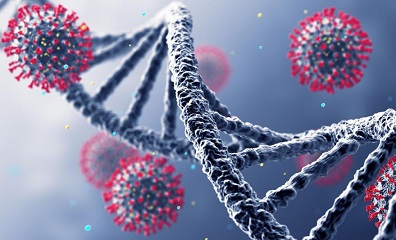Single Mutation F60S In SARS-CoV-2 NSP14 Can Impact Proofreading With An Increased Accumulation Of Mutations And An Elevated Evolutionary Rate!
Nikhil Prasad Fact checked by:Thailand Medical News Team Sep 20, 2023 2 years, 3 months, 1 week, 23 hours, 16 minutes ago
COVID-19 News: The COVID-19 pandemic, caused by the severe acute respiratory syndrome coronavirus 2 (SARS-CoV-2), has thrust virology and epidemiology into the global spotlight. One crucial aspect of virus behavior is its capacity for genetic diversity through mutations, which can have varying effects on the virus's properties, transmissibility, and resistance to antiviral drugs. SARS-CoV-2, being an RNA virus, exhibits a significantly higher mutation rate compared to DNA viruses, primarily due to the error-prone nature of its RNA-dependent RNA polymerase (RdRp). However, this virus has evolved a delicate mechanism to correct these errors through an exonuclease known as NSP14. This proofreading mechanism is vital for maintaining the accuracy of the viral RNA genome and preventing the rapid accumulation of deleterious mutations.

Despite the presence of the proofreading exonuclease, SARS-CoV-2 has still managed to adapt to the human host through the acquisition of mutations as seen in various studies and
COVID-19 News reports. The rate at which advantageous mutations emerge is influenced by the interplay between NSP14 and RdRp. Furthermore, coronaviruses can also undergo recombination, adding another layer of complexity to their evolutionary dynamics. Therefore, understanding the mutational processes in SARS-CoV-2 is crucial for comprehending the factors driving diversity within the virus population.
Structure and Function of NSP14 Exonuclease
The NSP14 exonuclease, a member of the DEED superfamily, plays a pivotal role in maintaining replication accuracy by removing erroneously incorporated nucleotides. This critical function is facilitated by a specific set of amino acid residues within the enzyme's active site, including two glutamic acid (E) residues, two aspartic acid (D) residues, and a histidine (H) residue. These residues coordinate two magnesium ions that activate water molecules for nucleophilic attack, ultimately excising the erroneous nucleotides.
Exonuclease Inactivation and Mutational Burden
Previous research has demonstrated that inactivation of the exonuclease in related coronaviruses, such as HCoV-229E and MERS-CoV, results in the inability to generate viable virions. However, inactivation experiments on SARS-CoV-1 and murine hepatitis virus (MHV) produced viable virions with compromised fidelity, leading to an increased burden of mutations and reduced fitness. Additionally, general mutations within the exonuclease have been associated with an increased mutation rate in SARS-CoV-2.
Interaction with NSP10
The exonuclease activity of NSP14 is modulated by its interaction with non-structural protein 10 (NSP10). Mutations at the NSP14/NSP10 interface have been shown to reduce exonuclease activity and render the virus attenuated or non-viable. This interaction enhances exonuclease activity significantly, demonstrating the critical role of NSP10 in maintaining replication fidelity.
The F60S Mutation and Allosteric Effects
The study by researchers from Cardiff University-UK focuses on a specific mutation, F60S, located at the interf
ace of NSP14 and NSP10. While this mutation is not expected to disassemble the NSP14/NSP10 complex, it is predicted to alter the interaction network within this interface. This alteration may perturb the allosteric communication between the interface and the active site of NSP14. The reduced number of residue interactions, changes in rotamer conformation, and shifts in eigenvector centrality observed in the mutant NSP14 suggest an allosteric effect. Such changes could impact the exonuclease's efficiency, potentially leading to an increased mutation rate.
Increased Mutational Rate and Evolutionary Implications
The study reveals that the SARS-CoV-2 lineage carrying the F60S mutation exhibits an elevated evolutionary rate compared to other contemporaneous lineages. This rate exceeds rates reported in previous studies identifying lineages with heightened evolutionary rates. The study team proposes that this specific lineage experienced mutational meltdown, leading to its extinction. However, before its demise, the high mutation rate allowed these viruses to explore sequence space, acquiring mutations associated with improved fitness and virulence.
Furthermore, an analysis of Spike protein mutations within the F60S lineage uncovered changes linked to Variants of Concern (VoC), immune escape, receptor binding, and furin cleavage site adaptations. The study suggests that the F60S lineage crossed a fitness threshold where the negative impact of detrimental mutations outweighed the benefits from advantageous mutations, resulting in extinction due to mutational meltdown.
Implications for SARS-CoV-2 Evolution
This research highlights a potentially critical route for rapid mutation generation in SARS-CoV-2, adding to the virus's capacity to recombine and generate diversity. The ability to adapt quickly in response to selective host pressures and environmental changes is a hallmark of viruses. Therefore, understanding the impact of exonuclease mutations on mutational dynamics is essential for deciphering the virus's evolutionary trajectory.
In conclusion, the study underscores the significance of the NSP14 exonuclease in maintaining replication fidelity in SARS-CoV-2. The F60S mutation serves as a key example of how even a single mutation at the NSP14/NSP10 interface can have profound effects on the virus's evolutionary rate. This work not only advances our understanding of SARS-CoV-2 mutational dynamics but also sheds light on the intricate mechanisms governing virus evolution, with potential implications for future research and interventions to combat the ongoing global health impact of this virus.
The study findings were published in the peer reviewed journal: Molecular Biology and Evolution. (Oxford Academic Journals).
https://academic.oup.com/mbe/advance-article/doi/10.1093/molbev/msad209/7279048
For the latest
COVID-19 News, keep on logging to Thailand Medical News.
